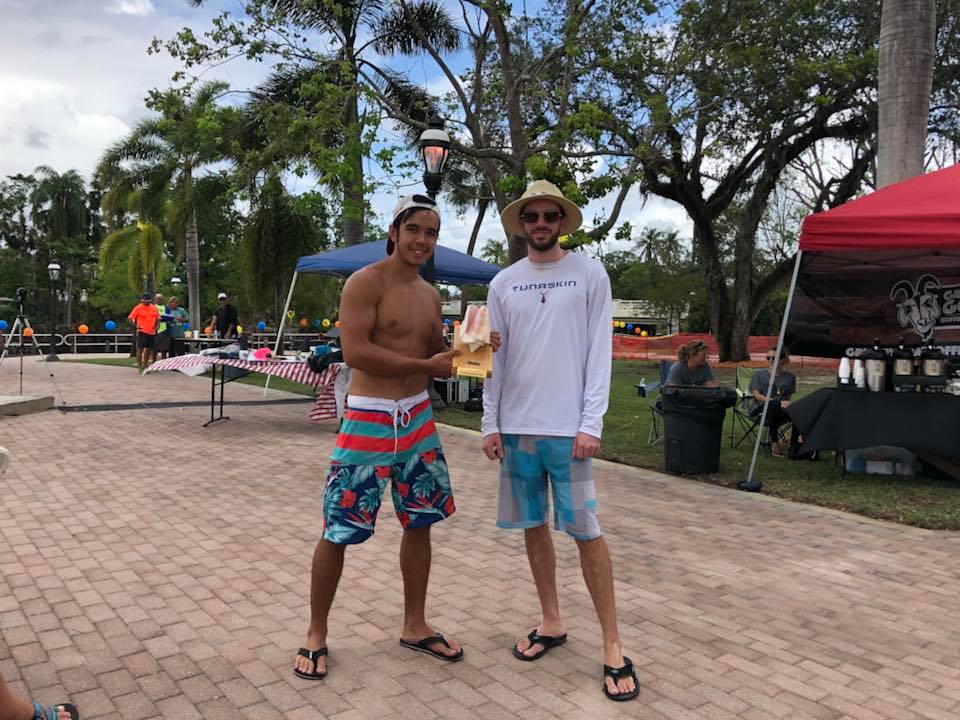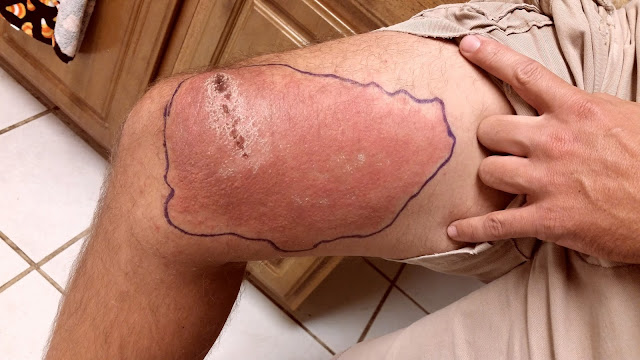
Hurricane Irma passed directly over my town of Bonita Springs, FL on September 10th 2017 as a category 2 or 3 storm with winds in excess of 160 kph and ~30 cm of rain. It was a big deal. Some people lost everything. I was lucky to suffer little more than the disorientation of a 1.5 week “pause” in my life. This is my Irma story.
Phase 1: Weather watching- I have loved weather-watching and weather-hoping since I was a kid in Washington State. Back then my psychic efforts were concentrated on hastening the arrival of spring and summer sunshine, particularly willing the waters to warm to swimmable temperatures, and, in the winter, wishing the rain to turn to school-cancelling snow. When I got hooked on windsurfing as a young adult, the weather-watching centered on wind. I also began to mix science with my wishing. I would pore over the
iwindsurf.com forecasts and sensor readings, and carefully strategize which beach to go to at what time to catch the best combination of wind strength and direction, tide level and flow, etc. Having by then moved to the East Coast of the US, I also started paying attention to tropical storms and hurricanes, which regularly influenced the weather of Virginia. Most of those brushes with storms in Virginia were harmless windsurfing fun, but
Hurricane Isabel of 2003 was a category 1 direct hit that really messed up the
Virginia Institute of Marine Science where I was studying, and left the area without power for several days. I regretted my decision to storm-watch from VIMS’ waterfront campus after my car window was smashed out by flying debris. Where I live now in Florida, hurricanes and tropical storms are the only kind of weather that’s interesting, so you can bet I do a lot of hurricane tracking and speculating, largely at the site wunderground.com, which has a good science blog discussion section along with their severe weather reporting. One of the things that concerned me this summer was how incredibly hot the water temperatures were in the Gulf of Mexico, much of it over 30 degrees Celsius. That’s hot enough to make you sweat while you swim. Hotter ocean waters give more energy to strengthen the winds and rains of tropical storms. The
sea surface temperature “anomalies” (how much hotter or colder it is than normal) were skewed remarkably hotter, a trend becoming the new normal around the world, no thanks to man-made global warming.
The climate change stuff was definitely on my mind as I watched the terrible destruction brought to Texas by
Hurricane Harvey. Then, before Texas had even dried off, a new storm developed in the Eastern Atlantic with a projected track that put Florida in the bullseye: Irma. I watched Irma get bigger and stronger, but thought it likely that she would curve out to sea; that the early track forecast of a direct impact to Florida would be wrong. However, each day the storm was stronger, and closer, and the westward track of Irma was narrowed the “cone of uncertainty” on South Florida. Remembering how beat up I’d been by category 1 Isabel in 2003, I wanted nothing to do with category 4 or 5 Irma.
Phase 2: Evacuation planning- It was hard to concentrate at work during the week of September 4-8, as I wondered whether, when, and where to evacuate. It didn’t seem like any of Florida would be a good place to go, since the whole state was in the “cone,” and even places not in the direct path of the storm would likely lose power (and precious air conditioning) for days. We considered two types of evacuation- 1) a short hop to more inland and northerly location in Florida, like a hotel in Orlando, or 2) a long journey to my parents’ house in Asheville, NC. Pros of the short evacuation would be less driving, and less time away from normal life if the hurricane damage turned out to be minor. Cons of the short evacuation would be finding a place that could take our dog, the expense of the hotel, and possibly needing to move again if our house was unlivable after the storm. Also, our geriatric bulldog-mutt Grace could suffer and die in a non-air-conditioned environment, so we needed the evacuation spot to be a guaranteed-cool place that we could afford to stay for a while. That argued strongly for Asheville. Thankfully,
Florida Gulf Coast University (my employer) cancelled Thursday and Friday operations, which gave us plenty of time to make the long drive to NC before the bad weather. Rhonda and I packed up Wednesday night after my last class at FGCU (only three students attended the class), and prepared to leave early Thursday morning.
I was queasy thinking of how vulnerable our little rental house was: Lousy old windows that the wind whistles through. A poorly anchored aluminum shed in the back, leaned against a mahogany tree with branches enveloping the power and cable lines from the street. A decaying detached screen porch half-wrapped in Bougainvillea and Virginia Creeper vines. A palmetto palm tree that grew up too close to the house with its stiff fronds batting at the gutter and eaves. Towering pines and ungainly Ficus trees in the adjacent lot. I was fairly sure that the shed and screen porch would be destroyed by the wind alone, and that the house windows would break or leak enough rain to rust the electronics and rot the walls and furniture. I also thought it likely that all Rhonda’s fish would die and stew in their aquariums, even if the storm missed us. Wanting to get out on Thursday we didn’t have much time to prep the house. We didn’t board up windows or doors, but we did move the outdoor furniture into the shed, took the desktop computers to a friend’s safer house, and shifted a few things up off the floor and away from the windows. At the last minute, after sunset Wednesday night, I decided to hack all the fronds off the palmetto palm so they couldn’t bang into the eaves. While I was doing that I forgot to move the expensive gas barbeque grill into the house.
Phase 3- Evacuation. When we left at 6:30 am Thursday morning, all we had with us was our laptop computers, a box of personal identification documents, a week’s worth of clothes and toiletries, and the dog and her food. We drove Rhonda’s car, and left my “sport utility” minivan in the driveway stuffed with my windsurfing gear.

Leaving it all behind, was actually a kind of relief. I felt as if I had already said goodbye to the material things, and knew that the most precious pieces of my life were in the car with me or at our destination in Asheville. The adventurous feeling of escaping kept my mood more positive and energized than it would normally be on such a long drive. I enjoyed watching the natural scenery change from perfectly flat with tropical vegetation to gently-rolling with oaks and pines. At the same time the cultural scenery changed from “uniquely South Florida” to “kind of like the rest of the rural South”. It was nice to trade driving duties with Rhonda, and to make lots of little rest stops with the doggie. At those stops, and soon on the roads, as well, it became plain that we were not the only people evacuating from Florida. It was a dog and human ZOO at every gas station and McDonalds.
Traffic was slow between Tampa and Gainesville, and fairly excruciating from there into Georgia. After 16 hours on the road, in the dark of night, we were gridlocked well south of Atlanta. It looked grim and we debated stopping for the night. However, a turn onto the backroads opened up uncrowded territory, and we pressed on into a hilly land of big trees and small towns that was beautiful by moonlight. A Redbull caffeinated energy drink helped me stay awake for the last few hours through the northwest corner of South Carolina and into the western mountains of North Carolina. Finally, at 5 am, we pulled into my parents’ Asheville driveway and stepped out into the shockingly chilly September night air.
Phase 4- Asheville. My parents moved to Asheville from Washingon State a few years ago, but somehow I had only ever visited them at Thanksgiving and Christmas. So when I finally woke up it was a delight to see the scenic mountain town with all the green leaves on the trees and the pretty flowers blooming in my mom’s garden. Of course it was also great to see my folks, and my biologist Aunt Mary Garland and Uncle Tom who live in the same neighborhood. My dad had a heart attack earlier in the summer and has been on a strict “
Ornish” diet and lifestyle program since then to get his weight, cholesterol and blood pressure down.
Dad making Ornish balls.
Apparently this Ornish thing is the only diet and wellness practice that has been scientifically studied and determined to actually clean out (rather than merely stabilize) clogged arteries. Old Johnny Douglass was looking studly and svelte for a 73 year old, and was in great spirits for a guy forbidden from eating any of his former favorite foods like BBQ pork and chocolate sundaes. I am extremely proud of him for sticking with something so difficult, and delighted that he’s doing something that greatly increases his chances of being alive and healthy for a good while longer. Rhonda and I went to Johnny’s “graduation” from his Ornish support group at the medical center, where we met some nice people who had also been prescribed the drastic lifestyle change at the same time as my dad. The graduation was an Ornish luncheon, some parts of which were wholesomely delicious and other parts of which gave me a greater appreciation for the adherents’ commitment to the program.
Some just-for-fun stuff that we did in Asheville included great walks and hikes in the mountains. I was especially stoked to drive to the high elevation areas along the Blue Ridge Parkway that are closed off when I normally visit in the late fall and winter. We even went to the highest spot of all,
2037 m Mount Mitchell, the highest point in the eastern United States. Above 1600 m elevation in the southern Appalachian Mountains there is a shift from familiar eastern deciduous forests to unique evergreen spruce and fir forests similar to those found far to the north in Canada. I had never been in that elevation zone before, and I found it remarkable to be bundled for warmth and surrounded by dark green fir trees in summer in a southern state. Mary Garland explained that one of the reasons Mt. Mitchell was so tall is because it was made of exceptionally hard rock, which had resisted erosion while the softer portions of the ancient Appalachians had worn away over the hundreds of millions of years since the Ordovician period.
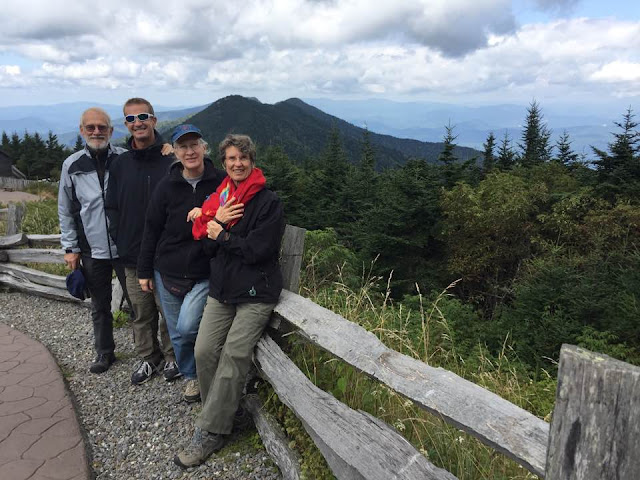 A pensive moment atop the Craggy Gardens overlook.
A pensive moment atop the Craggy Gardens overlook.
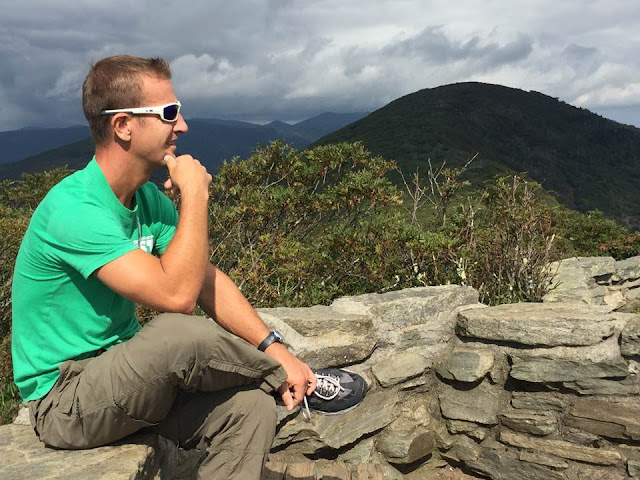
Another feature of the time in Asheville was a streak of social dinners. Rhonda got to experience one of the hallmarks of my parents’ lifestyle- that they love to have company over, especially when sons and daughters-in-law are around. I hope my own circle of friends is similarly full and entertaining when I get to retirement age. It would also be cool if I can somehow live near my sister or Rhonda’s siblings like my dad lives near Aunt Mary Garland, since it’s a holiday-like treat to have them around, even if we’re not doing anything special. On this visit I got to hear Mary Garland play the banjo, which she appropriately learned after moving to the southern hills. She plays “old time” music, which is similar to bluegrass, and she’s really good! My mom has also learned to play the dulcimer. Someday maybe I’ll try playing the piano again.
One thing I did entirely too much in Asheville was stare at Hurricane Irma news and forecasts on my laptop. The projected track shifted east (good for my town, bad for Miami) but then shifted west again to put Bonita Springs directly in its sights. As it looked like devastation of my home was highly likely, I persuaded my SUP racing buddy Justin DiGiorgio to break into my place and transfer my SUP boards from the vulnerable aluminum shed into the living room of the house itself. While he was at it he moved in the BBQ grill that I’d stupidly left out. Thank you Justin!
 Phase 5- The Hurricane Hits.
Phase 5- The Hurricane Hits. After devastating some Caribbean Islands at full category 5 strength, Irma spent a long time traversing the north coast of Cuba. While that was bad for Cuba, it degraded the storm’s strength and organization, particularly weakening its southern half, where the west winds resided. Irma re-strengthened to a marginal category 4 as it turned north and surged across the Florida Straits to the Florida Keys. It was dreadful to see it on the radar images, with the fluorescent violence of the eyewall smacking straight into middle/lower Keys. The next spot the eye came ashore was Cape Romano, where the dome homes I’d recently paddled to were. (Most of the domes are still standing, but two “sank” in the storm.) From there the eye went straight over Naples and my house in Bonita Springs, but that may actually have been a better scenario than if it had stayed a offshore where the winds would have pushed more of a storm surge to the north and west. As it was, only the barely-populated, south-facing coast of the Everglades got a big surge. The west-facing beaches from Naples and northward had a big NEGATIVE storm surge (the water went way out) due to the strong offshore east winds of the upper half of the hurricane, and had only minor positive storm surge from the weaker west winds of the lower half of the storm that passed over later. However, even that puny surge was enough to overwash the narrow dunes along the beaches in my town, salt-killing some of the seashore vegetation like the Sea Grape trees. The storm surge could have been MUCH worse, and we really were lucky that it wasn’t. What was bad was the wind damage. Even though the storm rapidly weakened, winds still reached over 160 kph where the eye passed over in SW Florida, which was enough to knock down TONS of trees, strip leaves and limbs off others, damage roofs, tip over fences and signs, etc. By some miracle, my shed survived, and I only lost one section of trim from my roof and one screen from my detached porch. (This was reported by Justin DiGiorgio when he inspected my house the next day.)
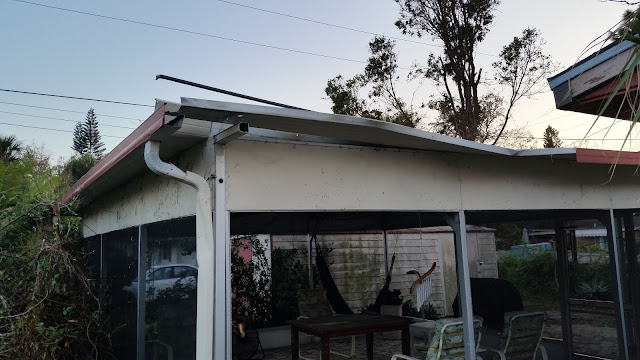
One part of the storm that was not merciful to Bonita Springs was the rain. About 30 cm fell onto soggy ground and drained into rivers and canals that had only partially recovered from flooding rains just two weeks earlier. The water quickly reached unprecedented highs and flooded lots of people’s houses. Some lower-lying neighborhoods on the east side of town had totally devastating flooding, and many of the houses I paddle by in the Imperial River had the river in their garages and living rooms. In fact, the AirBnB that my parents rented when visiting this January had a foot of water in it and all the furniture was moldering out on the curb when we got back to town.
Though it was a huge relief to hear that my house wasn’t destroyed, I had to suppress my urge to drive back right away. Reports from friends who stayed indicated that it was hellish and they wished they weren’t there. Not only was it horrendously hot and humid with no electricity, stores weren’t open, or didn’t have anything to sell. For example, it was nearly impossible to get gasoline for a few days. Plus, lots of roads were impassible because they were flooded and/or full of downed trees. There was no great urgency to return, anyway, because my work was cancelled until Monday the 18th.
Phase 6- The Return. Our unplanned vacation to my folks’ house in Asheville coincided with their planned seasonal migration to the Edisto Beach, SC house that they rent out in the summer but occupy for parts of the off-season. The timing and logistics of that migration were knocked askew by our visit, and by Irma, which caused some flooding, damage, and power outages on Edisto. Rhonda and I adapted by making Edisto an intermediate stop on our way home. I love any chance to visit Edisto and appreciated that it split the drive home into smaller segments. We left Asheville on the afternoon of Thursday the 14th and arrived at Edisto just after dark. There were lots of tree limbs down and sand and puddles in the road at Edisto, but the damage was minor relative to the major whallop the island received after Hurricane Matthew in 2016. Mainly Irma just made for more interesting beach combing there, with lots of strange shells and debris washed up.
After one restful day at Edisto, Rhonda and I bid my folks adieu and made an early morning departure for Florida. Traffic wasn’t bad, and as with the evacuation, the sense of adventure and excitement made the time shorter. Whenever I wasn’t driving, my eyes were scanning the roadsides for hurricane damage, expecting it to increase steadily the further south we got. At first the damage did increase. We noticed more trees down and billboards damaged as we headed down I-95 through Jacksonsville and St. Augustine. There was a fair amount of damage even as we turned inland on I-4 through Orlando. But oddly enough, there wasn’t much damage (at least not visible from the freeway) as we drove south on I-75. Even as far south as Punta Gorda things didn’t look bad. It wasn’t until we got to Fort Myers that we saw a major increase in damage, with many broken and uprooted trees, busted signs, etc. We took an earlier exit than unusual because it was reported that there was still water over the roadway near our usual exit. Once off the freeway there was a spectacle of chaotic damage. On our own street it was incredible. The entire vista was transformed by the knocked-down fences and absent tree canopies. It felt like there was more sky. Also incredible was the level of the little creek across the street from us than runs into the Imperial River. It was rushing and swollen and as wide as the Imperial itself, even days after peaking. I put on boots and walked to our friends’ house in a neighborhood along the creek, and sadly saw their house surrounded by the rushing water, which had clearly been in the house, as well.
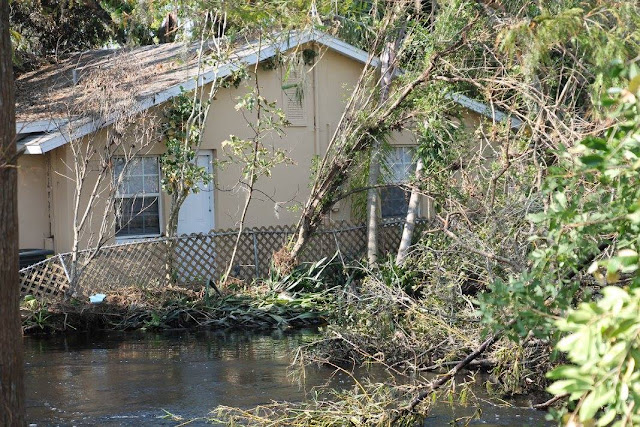
A short walk to the Imperial River revealed it to be entirely filling Riverside Park where our SUP races take place, with only the tops of the park benches showing above the surface.



Though everything in my Bonita Springs looked damaged, perhaps the worst-looking disaster was the Everglades Wonder Gardens, and old-timey reptile house and botanical garden where it seemed all the giant tropical trees planted in the 1930s had come down and crashed on each other and over and through the tall wooden fences around the gardens. (I hear they’re selling the lumber though, which makes sense. There ought to be a fortune’s worth in timber, firewood and pulp just from all the giant piles of yard waste on everyone’s street front now.)
Inside our house it was 31 degrees Celsius and dank, but blessedly there was no serious water damage- just a tiny puddle in one closet where sideways rain had penetrated the hole drilled in the wall for the tv cable to come through. By some miracle, Rhonda’s freshwater aquariums still looked healthy and had some living fish. I think the ones that died probably nourished those that remained. The refrigerator and freezer were somewhat disgusting, but the fact that the power had been on for a day or two before we got back at least meant that the oozes had congealed enough to be easy to clean up.
On the second day of cleanup we dealt with the yard waste. My buddy Matt helped me chainsaw our downned mahogany limbs in exchange for me helping him out with a bunch of fun chainsawing at his house, including disassembling an entire huge avocado tree. I like chainsawing.
 Phase 7- Moving on.
Phase 7- Moving on. Life is gradually getting back to normal now. I survived my first week back at work with only about double the level of disorganization and absent-minded professor confusion that I usually have. I tried to avoid the river because of stinking germ concerns, but I couldn’t stop myself from getting a nice 20 knot windsurfing session at Bonita Beach on Monday night. After that, and it may have just been coincidence, I got a cold that dampened the rest of the week, but it’s passing now. The morning I wrote this was the first time I got on a paddleboard since before Irma, and I did a loop around Big Hickory Island on Estero Bay with Justin. The ocean water is a little brown but has been certified swimmable by the Lee County organization who tests it. I am somewhat skeptical of that safety certification. The Estero Bay water is far more suspect. It looks like black coffee and smells like wet garbage. My graduate student Lisa was actually out in the Bay measuring its salinity and optical water properties on Thursday the 14th just a few days after Irma. Incredibly, she found nearly fresh water throughout the Bay (0 – 7 ppt salinity), even in areas that are normally near marine salinities (35 ppt). The combination of black water and very low salinities bodes ill for the seagrasses that Lisa and I are studying, which depend on clear, sunlit water and salinities >20 ppt. Compounding this “natural” disaster will be the extremely high concentrations of Nitrogen and Phosphorus washed into the water from all the overflowing septic and sewage systems, golf course ponds, farms, and other human sources of excess nutrients. They’re likely to cause harmful algal blooms that will negatively impact any remaining seagrasses. It’s an ugly situation, for sure.
While hurricanes are a natural phenomenon, their frequency, severity, and destructiveness are all increased by things that humans do. Global warming is the big one because it soups up the wind power and rain content of storms, and raises the sea level making storm surges go further. Another category of things we do that increase the destructiveness of storms includes removing or degrading the natural ecosystems that block or buffer the storm effects. For example, by letting coral reefs die we remove those natural breakwaters from our shorelines. Replacing beach dunes, marshes, and mangroves with coastal development removes those natural barriers and puts human structures in harm’s way. Inland, sprawling developments increase flooding problems by preventing the ground from absorbing rainwater, and concentrating all the water into overloaded and poorly-designed artificial drainage systems. To plan for the future we should take strong action to curb global warming, we should put the brakes on developments that are themselves vulnerable to flooding and storm surges and/or make other areas more vulnerable, and we should protect and enhance the natural ecosystems that process and store rain and floodwaters. In a best-case scenario, I imagine the wave of urban sprawl cresting about now, then tactically receding from the most vulnerable areas by not rebuilding the same way in the same spot when things are destroyed, instead shifting population density to sturdier structures on higher ground and yielding the beaches and floodplains to parks and nature.
